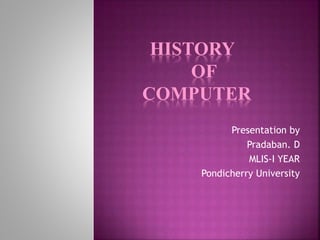
History of computer
- 1. HISTORY OF COMPUTER Presentation by Pradaban. D MLIS-I YEAR Pondicherry University
- 2. As early as the seventeenth century, mathematicians were trying to create a machine that could perform basic mathematical functions such as, addition, subtraction, division and multiplication.
- 3. Charles Babbage (1791-1871) An English mathematician, Professor Charles Babbage made a “difference Engine” in 1833, which was powered by steam to solve mathematical equations. After 10 years, in 1842, he made a general purpose computer named “Analytical Engine”. This analytical engine could add, subtract, multiply and divide in automatic sequence at a rate of 60 additions per second.
- 4. First Generation 1940-1956: Vacuum Tubes Second Generation - 1956-1963: Transistors Third Generation - 1964-1971: Integrated Circuits Fourth Generation -1971Present:Microprocessors Fourth Generation -1971Present:Microprocessors
- 5. The first computers used vacuum tubes for circuitry and magnetic drums for memory, and were often enormous, taking up entire rooms.
- 6. Technology- Vacuum Tubes Memory -Magnetic drums Language-Machine Language Input -Punched cards and paper cards Memory capacity-10,000 to 20,000 characters Output - Printout Application -record keeping Beginning of data processing business
- 7. Demerits Very expensive Relatively slow Great deal of electricity Very large in size and weight Generated a lot of heat Not programmable Unreliable Non portable Examples ENIAC- Electronic Numerical Integrator And Calculator ( Eckert & Archly). UNIVAC(Universal Automatic Computer) I, UNIVAC II EDSAC (Electronic Delay Storage Automatic Calculator) Whirlwind
- 8. Transistors replaced vacuum tubes and ushered in the second generation of computers. The transistor was invented in 1947 but did not see widespread use in computers until the late 50s. smaller, faster and cheaper.
- 9. Technology- Transistors Memory - Magnetic core Language- assembly Languages, high level programming languages Input - Punched cards Memory capacity- 4,000 to 64,000 characters Output - Printout Application - record keeping, billing, etcRapid growth in data processing applications
- 10. Merits Smaller size compared to 1st generation computers More reliable Better portability Less heat generated Less prone to hardware failures Demerits Frequent maintenance required Air conditioning required Commercial production was difficult and costly Example UNIVAC III IBM 7070
- 11. The development of the integrated circuit was the hallmark of the third generation of computers. Transistors were miniaturized and placed on silicon chips, called semiconductors, which drastically increased the speed and efficiency of computers.
- 12. Technology- Integrated Circuits Memory - Magnetic disk Language- high level programming languages Input - Key board, mouse, OCR etc Memory capacity-32,000 to 4 million characters Availability of OS Internet started Significant improvement in the development of SW and OS Application -Airline system, market forecasting, credit card billing etc.
- 13. Merits Computers were smaller Faster, more reliable and needed less power Easily portable, lower heat generator. Maintenance cost is law because HW failures are rare Demerits AC required Highly sophisticated technology required for the manufacture IC. Example Honeywell 200 IBM system/360 Burroughs 6700
- 14. The Microprocessors brought the fourth generation of computers, as thousands of integrated circuits were built onto a single silicon chip.
- 15. Technology- Large scale Integrated Circuits Language- all higher level programming languages Input - Key board, mouse, GUI, OCR etc Application - Electronic fund transfer, etc
- 16. Features Availability of programs for special applications Introduction to networking and home computers Improved secondary storage Very reliable Smallest in size Cheaper Easily portable No AC required
- 17. Fifth generation computing devices, based on artificial intelligence, are still in development, though there are some applications, such as voice recognition, that are being used today.
- 18. Based on artificial intelligence are still in development. Use of parallel processing. Extremely large scale integration.
- 19. Automatic Speed Accuracy Diligence Versatility Power of Remembering No IQ No Feeling Storage
- 20. THANK YOU